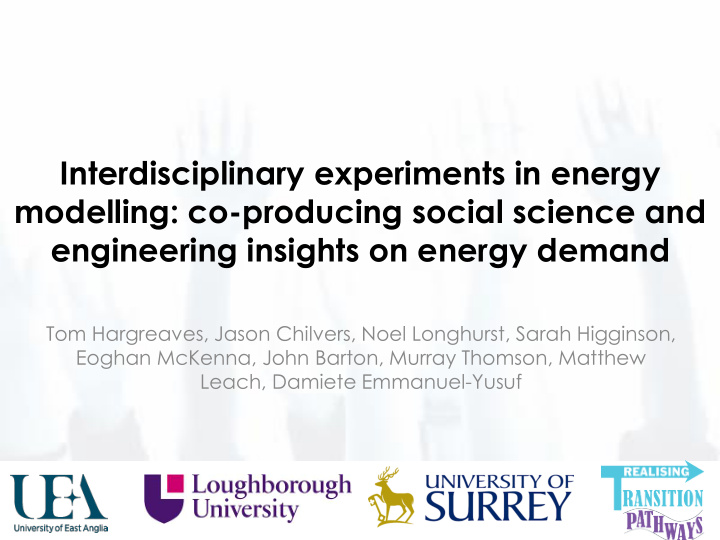



Interdisciplinary experiments in energy modelling: co-producing social science and engineering insights on energy demand Tom Hargreaves, Jason Chilvers, Noel Longhurst, Sarah Higginson, Eoghan McKenna, John Barton, Murray Thomson, Matthew Leach, Damiete Emmanuel-Yusuf
The energy integration challenge “One of the main challenges…is to identify and integrate the social aspects and governance implications…with the body of knowledge on technical feasibility.” (Darby and McKenna 2012)
Integration and Interdisciplinarity • Interdisciplinary (ID) research is often evaluated for the extent of integration between the disciplines. – A spectrum from Multi-, through Inter-, to Trans-disciplinarity. • This leads to the development of ‘best practice’ guidelines for ID research. – E.g. ‘right’ team, ‘right’ space, ‘right’ time, ‘common’ language, open and trusting environment etc. (e.g. Sinnett and Williams 2011) • T his approach assumes that ‘integration’ is always desirable, that it is the only appropriate goal for ID research.
Diverse modes/styles of interdisciplinarity Integrative-synthesis: Subordination-service: Agonistic-antagonistic: “the integration of two or “service discipline(s) “driven by an …antagonistic relation to more antecedent making up for an absence disciplines in relatively of lack in the other, existing forms of symmetrical form.” (master) discipline(s).” disciplinary knowledge.” (Source: Barry et al 2008, p28-29)
Realising Transition Pathways “To undertake historically-informed, forward- • looking analysis of energy system transitions, bringing together quantitative and qualitative research methods.” Explicit research on ID during the first phase • concluded that, despite willingness, the consortium struggled with ‘on - model’ collaboration. Phase 2 has sought actively to experiment • with different kinds of on-model interdisciplinarity in relation to demand response. – Workshop 1: explored model ‘assumptions’ – Workshop 2: devised range of ID experiments – Workshop 3: To evaluate process.
Experiments in interdisciplinarity Engineer-led DR Calculator 1. Standard modelling 3. Social critique Service Expectation Qualitative narratives Society Academy Evolution in existing models based based 2. Social Science-led modelling 4. Co-production Modelling Practices Co-produced (Laundry/Driving) DR model Social science-led
Service Expectation Evolution Designed to provide social science input into existing RTP • models in order to ‘improve’ their assumptions about indoor comfort expectations. Service expectations often held to be stable and • constant in models, but social science literature suggests they vary in different ways: Process: • 1. Review of social science literature on indoor comfort expectations 2. Devise range of modelling scenarios all backed by evidence (stabilise and standardize; more demanding standards; wider comfort zone; local diversity) 3. Modelling variable service expectations 4. Evaluate process (Summer 2015)
Service Expectation Evolution In each hour: Heating / Cooling Demand Ongoing Learning: Opens up new scenarios for • models. Introducing new parameters and re-framing Wide or Narrow boundary conditions. Zone Demands new levels of detail in • existing models (e.g. around heating/cooling technologies, Internal temperature housing stock etc.) Annual total energy demand: Forces social scientists to • appreciate complexity of models and difficulty of making even small Heat Demand changes to assumptions. Generates a new understanding of • model outputs with stronger awareness of what’s been left out and why. °C 0 2 4 6 8 Width of internal Temperature comfort zone
Modelling Practices • Social-science-led experiment designed to develop new approaches to modelling based on social science understandings of, and data about, social practices. • Process: 1. Identify key assumptions/understandings of social practice theory. 2. Gather data in relation to laundry practices (and subsequently driving practices) 3. Explore ways of representing/modelling data based on network theory. 4. Evaluate process (Summer 2015)
Modelling Practices 1. Simple home laundry (12) 2. On-demand home laundry (2) 3. Simple outsourcing (1) 4. Attentive clean laundry (6) 5. On-demand outsourcing (2) 6. Hand washing (4) Figure 8 – Networks of laundry variants. The number of performances of each variant is indicated in brackets.
Modelling Practices Ongoing Learning: • Forces engineers to explore wholly new understandings of socio-technical change and question their model-ability. • Forces social scientists to move beyond situated/in-depth case studies and engage with new ways of ‘scaling up’ and communicating about practices. • Opens up new discussions about core/periphery elements, variants of practice etc. but also closes down discussion about the situatedness of practices.
Conclusions Engineer-led 3. Social critique 1. Standard modeling Public exploration of TP models AQ model assumptions DECC 2050 (Yearly, 2000) CSE Open Data Collaboration Service Expectation Society Academy Initiative Evolution based based Quant/Qual integration CAT Zero Carbon modelling Britain Appraisal Bottom up qualitative modelling Competency groups Modelling (Lane et al. 2011) Practices 2. Social Science-led modeling 4. Co-production Social science-led
Conclusions 1. There is no single ‘best practice’ approach… diversity matters. The challenge is to experiment with a range – of approaches and to be reflexive about their effects and implications. 2. This will help to develop a broader range of evaluative criteria for ID work. E.g: Transformations of actors/inputs to ID working – Styles/Modes of ID working – Opening up of ID outputs –
Thanks Tom.Hargreaves@uea.ac.uk
Recommend
More recommend